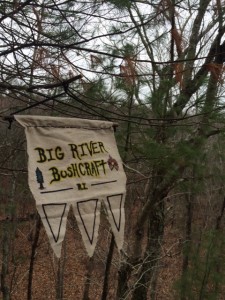 What exactly is bushcraft? Even after checking Wikipedia, following many hobbyists on Instagram, and getting detailed descriptions from various friends of mine with whom I partake, I am still not 100% sure what it is. At its most basic, it is the application of wilderness survival skills. Starting a fire with flint and steel, constructing a proper shelter, and cooking food in the wild are common practices. The term seems to cover many more outdoor activities such as hunting, fishing, foraging and camping. This is why it is hard for me to nail down exactly what this growing pastime is. It seems to cover all recreational areas of the outdoors.
What exactly is bushcraft? Even after checking Wikipedia, following many hobbyists on Instagram, and getting detailed descriptions from various friends of mine with whom I partake, I am still not 100% sure what it is. At its most basic, it is the application of wilderness survival skills. Starting a fire with flint and steel, constructing a proper shelter, and cooking food in the wild are common practices. The term seems to cover many more outdoor activities such as hunting, fishing, foraging and camping. This is why it is hard for me to nail down exactly what this growing pastime is. It seems to cover all recreational areas of the outdoors.
Packing light is a crucial consideration in bushcraft. On a long hike, the less weight you carry, the better. The idea is to get the most you can out of the least you can bring. Ideally, your skills would make up for what you lack in gear. At least this is how I see it.
A few weeks ago, my friend Jay and I took to the woods. After a nice hike in, we settled at a spot that sits on top of a large rock cliff and stands high above the woods below. A brief moment of vertigo kicked in, but it quickly turned into excitement as I took in the view. We enjoyed the silence, which was broken by Jay’s signature phrase, “We’re there!” It was time to build up our spot.
The first order of business was to decide where to set up camp for the day. Being closer to the cliff offered an amazing view, but it would be colder. Farther away from the cliff would be warmer, but we would miss out on the stunning visual. We decided to go with the view.
It was time to get a fire going, and I did the honors. On the hike in, Jay collected tinder off of old trees and sticks and handed me a clump to get started on. For this, I had a challenge in mind. He once gave me a ferro rod, which is a stick of flint, and a striker, which is used to create a spark off of the rod. However, both were very short. The small size serves nicely as a backup fire kit, but a longer one throws a much stronger spark. Although Jay offered me his longer and more practical ferro rod, I thought it would make for a good challenge to get the fire going with the one I had. It is the one I carry in my pack, so in a pinch, I should be able to use it.
After about 10 strikes of the flint and no luck (it usually takes me one or two), I remembered that I had a pouch full of tinder in my pack from the hike we did the week before. It was comprised mostly of birch bark scrapings, which catch fire relatively easily.
I piled on the new batch of tinder, and after about four or five tries, it went up in flames. I sprinkled some twigs over the bundle, then carefully placed some bigger sticks, then a few logs of harder wood over the growing flame. My backup kit worked, and we had fire.
Normally on these kinds of excursions, we would have some kind of culinary project prepared. Cooking and eating a meal is often the focus of our outings. On this day, we took a step back. We stopped at a dollar store where we each bought a can of creamy chicken soup. With a little Sterno stove and some savvy cookware, we made ourselves a warm and welcome trail meal. Jay boiled up a pot of coffee on a device he created from a cocktail shaker.
A lot of consideration was given to the set-up of our camp. We angled a tarp in such a way to contain the heat coming off of the fire. We hung a hammock, cleared debris, and made ourselves a leisurely spot to spend the afternoon. With our meal, some coffee and a little whisky to warm us up, we were living like kings.
All kings need a flag, so Jay made one that marked our little spot in the Big River area of West Greenwich. It hung proudly for the day on a tree at our site.
When it was time to leave, packing up was quick and easy. Everything we brought in with us fit into our packs. Tarps folded up tightly, cookware stacked into neat piles, and whisky bottles were lighter on the way out than on the way in.
Each time we go out, we are getting better and more efficient with our bushcraft. We are also getting more creative with our use of space. We are getting closer and closer to creating our own little paradise in the woods.
I have come to believe that bushcraft is a term that encompasses all areas of wilderness skills used on a leisurely basis. If you are interested, look it up and give it a try. There are many great books and articles on the subject. Maybe I’ll see you on the trail, or perhaps off the beaten path.


